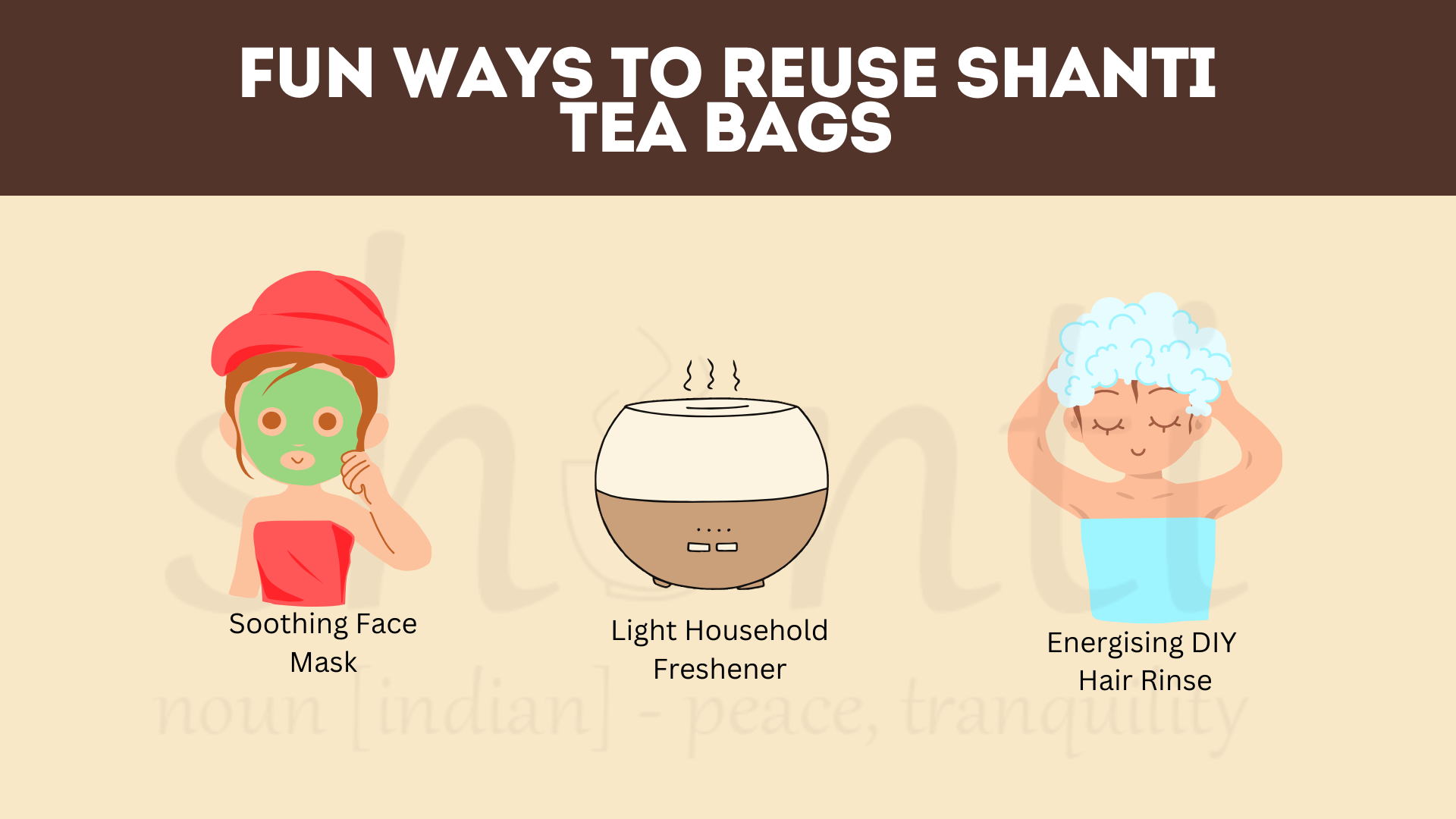Recycling Tea Bags by Shanti: A Sustainable Choice for the Environment & You

Table of Contents
1. Why Recycling Tea Bags Matters
We all know how popular tea is—some reports indicate that 4% of all brews in the UK are made with tea bags. Considering the country’s staggering daily tea intake, that’s a lot of single-use products ending up in landfills. When ordinary tea bags aren’t biodegradable or compostable, they contribute to landfill accumulation and greenhouse gas emissions.
A Tiny Bag With a Big Environmental Impact
- Plastic Content: Standard tea bags often contain polypropylene or nylon to stop them from tearing. This makes them non-biodegradable and results in microplastics lingering in landfills (and potentially in the soil).
- Landfill Volume: It may not seem like much if you’re discarding just a few tea bags a day, but multiply that by millions of households—soon, it’s a significant environmental burden.
By choosing recycling tea bags and disposing of them properly—often by composting—you’re making one of the simplest, most practical strides toward a more sustainable lifestyle .

4% of all tea’s made by brits are brewed from tea bags, leading to millions in single-use tea bags being put into landfills.
2. Shanti Tea: Eco-Friendly & Health-Focused
Many of us consider tea a comfort drink, particularly during busy or stressful times. But imagine if that daily pick-me-up also offered peace of mind—better for the planet, and better for you. That’s the ethos behind Shanti Tea.
A Holistic Focus on Women’s Wellness
Shanti Tea isn’t just another brand jumping on the eco-friendly trend. It was created with women’s health at its core—especially addressing issues like menstrual discomfort, PCOS, postpartum challenges, or plain old stress.
While caffeinated blends can sometimes exacerbate hormonal imbalances, herbal teas often provide gentler, more nourishing benefits. By blending carefully selected herbs and botanicals, Shanti Tea delivers natural solutions aligned with women’s wellbeing.
What Makes Shanti Tea Eco-Friendly? 100% Biodegradable and Toxin-Free Packaging
Shanti Tea goes the extra mile by ensuring every aspect of our product is eco-conscious. Here’s how:
- Packaging Recyclability: All external packaging can go straight into the recycling bin—less waste, less hassle.
- Compost-Friendly Tea Bags: Each tea bag can be placed in your compost bin without worrying about microplastics or harmful chemicals.
- Multiple Uses: Every single tea bag can actually be used 3 times before you finally discard it. Talk about getting the most out of each brew!
These thoughtful choices not only reduce your environmental footprint but also ensure a cleaner, safer cup of tea for you.

Shanti Tea is committed to creating natural toxin-free teas that benefit both women’s well being and the environment by choosing sustainable sourcing and green-friendly packaging for our products.
3. Recycling & Composting Tips for our tea bags
Curious about how to dispose of your Shanti Tea bags responsibly? Composting is a fantastic way to reduce waste and enrich the soil. Here’s what you need to know:
- Check the Label: Shanti Tea bags are marked as 100% biodegradable and compostable, so you can rest easy knowing they’ll break down fully.
- Compost Bin Guidelines: Once you’ve brewed your tea, give the bag a gentle squeeze to remove excess water and pop it into your compost bin.
- Possible Remnants: Occasionally, even biodegradable bags may leave a thin “skeleton.” If that happens, simply sieve it out and discard.
- Recycle the Packaging: All external packaging can be tossed in the recycling bin, ensuring minimal waste at every stage.
While it might seem like a small routine detail—composting a single tea bag—it can collectively reduce a huge amount of landfill waste and help cultivate richer, more fertile soil

Shanti tea bags and packaging is 100% biodegradable. You can simply toss it into your compost or recycling bin after use
4. Creative Ways to Reuse Shanti Herbal Tea Bags at Home
Slumber Shanti: A Soothing Face Mask
Slumber Shanti’s gentle blend (chamomile, peppermint, spearmint, and valerian root) is ideal for a calming skincare treat.
- How to Use:
- Re-Brew & Cool: Place your used Slumber Shanti bag into a small bowl of lukewarm (not hot) water for a mild infusion.
- Create a Mask Base: Mix the cooled tea with a teaspoon of plain yoghurt or aloe vera gel.
- Apply Gently: Spread over clean skin, avoiding the eye area. Leave on for about 5–10 minutes, then rinse with cool water.
- Tip: Always do a quick patch test on your wrist or jawline to make sure your skin loves this herb-infused treat.
Hormone Happiness: Light Household Freshener
- How to Use:
- Dry the Leaves: After steeping, remove the leaves from the tea bag and spread them out on a plate to air-dry completely.
- Small Sachet or Bowl: Place dried leaves into a tiny sachet or a small bowl. Tuck it into corners of your fridge or a musty cupboard.
- Milder Infusion: If you’d like a quick spray freshener instead, re-brew the bag in tepid water for a gentler infusion and do a small test on fabrics or surfaces before using widely.
- Tip: Because Hormone Happiness includes ginger and liquorice, the aroma can be a bit strong—start small, and ensure your fridge or cupboard is well-ventilated.
Blissful Buzz: An Energising DIY Hair Rinse
Blissful Buzz blends invigorating herbs like lemongrass, spearmint, and nettle—perfect for a stimulating scalp treatment.
- How to Use:
- Mild Re-Brew: Let the used tea bag soak in warm water for a few minutes (avoid scalding temperatures).
- Cool & Rinse: Once lukewarm, pour the infusion over freshly shampooed hair, gently massaging it into the scalp. Let it sit for a minute or two before rinsing with water.
- Test First: If you have sensitive skin or are prone to allergies, do a quick patch test on your wrist or behind your ear before applying to the entire scalp.
- Tip: This light, herbaceous rinse can leave your hair smelling subtly fresh. Use it occasionally as a mini spa moment in your routine.

There are creative ways to reuse herbal tea bags. You can re-use the Shanti tea bags to make DIY hair masks, face masks and a natural household freshener.
5. Why Shanti Tea is the Best Choice for Sustainable Living?
At this point, you may be wondering: What makes Shanti Tea stand out from other herbal brands offering eco-friendly packaging? Here’s why we think you’ll love them:
- Women-Centred Wellness: From balancing hormones to easing stress, these blends are specially formulated for women’s health needs.
- Sustainable Packaging: Every step—from the outer box to the tea bag itself—is made with the environment in mind.
- Quality Ingredients: A blend of adaptogenic herbs, antioxidants, and plant-based nutrients ensures both flavour and therapeutic benefits.
- Multiple Brewing Options: Use each bag up to 3 times, cut it open for a loose-leaf vibe, or brew it cold for iced tea—because variety is the spice of life.
- Strong Brand Mission: Shanti Tea is built on the belief that you can nurture yourself and the planet at the same time, without compromising on taste or convenience.

There are creative ways to reuse herbal tea bags. You can re-use the Shanti tea bags to make DIY hair masks, face masks and a natural household freshener.
6. Conclusion
Recycling tea bags may sound like a small act, but it symbolises a larger lifestyle shift toward conscious living. Every time you brew a cup of Shanti Tea, you’re making a series of caring decisions—opting for toxin-free ingredients, standing up for women’s health, and minimising landfill waste. That’s no small feat for something as everyday as a cup of tea!
Head on over to Shanti Tea for more details on our blends and our promise to the planet. Let’s raise our cups to a healthier, more sustainable future—one mindful brew at a time.
